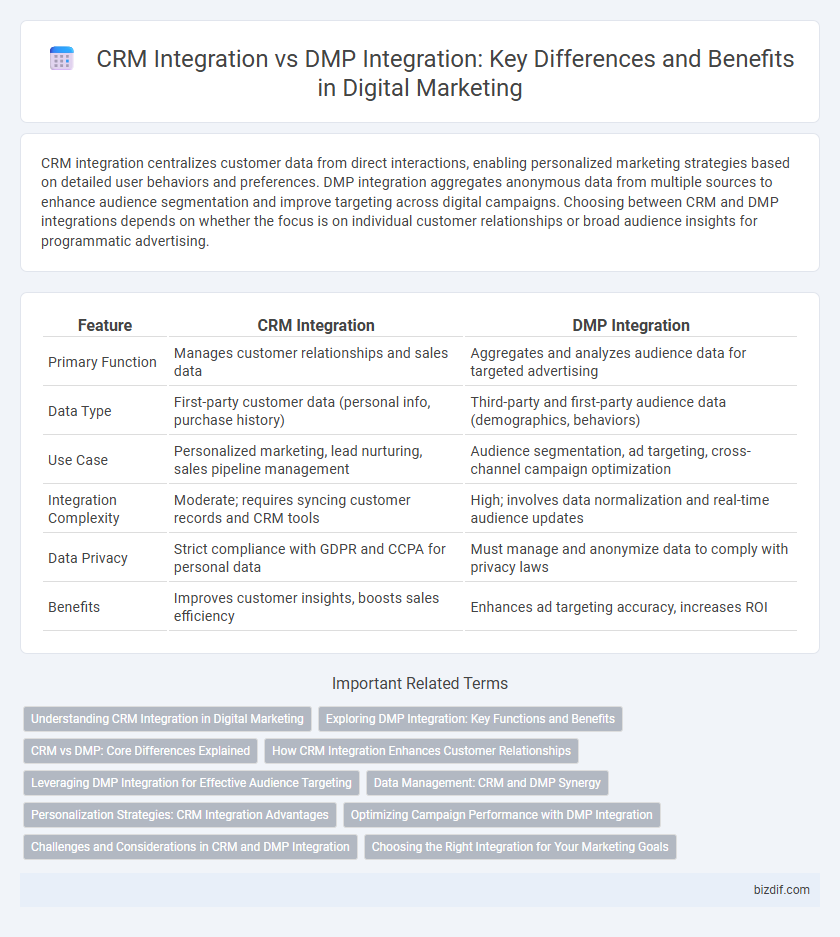CRM integration centralizes customer data from direct interactions, enabling personalized marketing strategies based on detailed user behaviors and preferences. DMP integration aggregates anonymous data from multiple sources to enhance audience segmentation and improve targeting across digital campaigns. Choosing between CRM and DMP integrations depends on whether the focus is on individual customer relationships or broad audience insights for programmatic advertising.
Table of Comparison
| Feature | CRM Integration | DMP Integration |
|---|---|---|
| Primary Function | Manages customer relationships and sales data | Aggregates and analyzes audience data for targeted advertising |
| Data Type | First-party customer data (personal info, purchase history) | Third-party and first-party audience data (demographics, behaviors) |
| Use Case | Personalized marketing, lead nurturing, sales pipeline management | Audience segmentation, ad targeting, cross-channel campaign optimization |
| Integration Complexity | Moderate; requires syncing customer records and CRM tools | High; involves data normalization and real-time audience updates |
| Data Privacy | Strict compliance with GDPR and CCPA for personal data | Must manage and anonymize data to comply with privacy laws |
| Benefits | Improves customer insights, boosts sales efficiency | Enhances ad targeting accuracy, increases ROI |
Understanding CRM Integration in Digital Marketing
CRM integration in digital marketing centralizes customer data from multiple touchpoints, enabling personalized campaigns and improved customer retention through detailed behavioral insights. Unlike DMP integration, which primarily focuses on anonymous audience data and third-party cookies for targeted advertising, CRM integration leverages first-party data to build comprehensive customer profiles. This approach enhances customer segmentation, optimizes marketing automation, and drives higher ROI by delivering tailored experiences based on individual customer journeys.
Exploring DMP Integration: Key Functions and Benefits
DMP integration centralizes first-, second-, and third-party data to create comprehensive audience segments for precise targeting and personalized digital marketing campaigns. Key functions include data aggregation from multiple touchpoints, audience enrichment, and real-time activation across advertising platforms, enhancing campaign efficiency and ROI. This integration enables marketers to optimize ad spend, improve customer insights, and drive higher engagement through data-driven decisions.
CRM vs DMP: Core Differences Explained
CRM integration focuses on managing direct customer relationships by collecting and analyzing first-party data such as contact information, purchase history, and service interactions to enhance personalized marketing campaigns. DMP integration aggregates anonymized third-party audience data from various sources to build broad customer segments for targeted advertising and media buying at scale. The core difference lies in CRM's emphasis on known customers and personalized engagement versus DMP's role in leveraging anonymous data for audience segmentation and programmatic advertising optimization.
How CRM Integration Enhances Customer Relationships
CRM integration centralizes customer data from multiple touchpoints, enabling personalized marketing campaigns tailored to individual preferences and purchase history. By unifying sales, service, and marketing information, businesses gain comprehensive insights that improve customer engagement and retention. Enhanced automation and data accuracy from CRM integration facilitate timely follow-ups and targeted communication, strengthening long-term customer loyalty.
Leveraging DMP Integration for Effective Audience Targeting
Leveraging DMP integration enhances audience targeting by consolidating vast amounts of third-party data, enabling precise segmentation based on behavior, demographics, and interests beyond first-party CRM data. Unlike CRM integration, which centers on existing customer relationships and historical transactions, DMP integration provides real-time insights and predictive analytics that drive dynamic advertising strategies. This approach maximizes reach and ROI by delivering personalized marketing messages to high-value prospects across multiple digital channels.
Data Management: CRM and DMP Synergy
CRM integration centralizes customer data by collecting, organizing, and analyzing first-party information to enhance personalized marketing strategies and improve customer retention. DMP integration aggregates anonymized third-party data from multiple sources, enabling targeted audience segmentation and optimized ad placements. Combining CRM and DMP data creates a robust data management system that unifies individual-level insights with broader behavioral patterns, driving more precise and effective digital marketing campaigns.
Personalization Strategies: CRM Integration Advantages
CRM integration enhances personalization strategies by leveraging first-party customer data to deliver highly targeted and relevant marketing messages. It enables precise segmentation based on purchase history, behavior, and preferences, fostering deeper customer relationships and higher conversion rates. Unlike DMP integration, CRM-driven personalization ensures real-time data accuracy and long-term customer insights for sustaining loyalty and improving customer lifetime value.
Optimizing Campaign Performance with DMP Integration
DMP integration enables advanced audience segmentation and data unification from multiple sources, enhancing campaign targeting precision beyond traditional CRM capabilities. By leveraging real-time behavioral data and third-party insights, marketers can optimize ad spend and increase conversion rates through personalized messaging. This data-driven approach significantly improves campaign performance by aligning marketing efforts with dynamic consumer behaviors and preferences.
Challenges and Considerations in CRM and DMP Integration
Challenges in CRM integration include data silos, inconsistent data formats, and ensuring real-time synchronization across platforms, which can hinder personalized marketing efforts. DMP integration faces obstacles in unifying anonymous and known user data, maintaining data privacy compliance, and managing large-scale third-party data sources. Considerations for both involve aligning integration strategies with business goals, investing in scalable technology, and prioritizing data quality to optimize targeting and customer insights.
Choosing the Right Integration for Your Marketing Goals
CRM integration centralizes customer data from sales and service interactions, enabling personalized marketing campaigns and improved customer retention through targeted communication. DMP integration collects and analyzes anonymous user data from multiple online sources, enhancing audience segmentation and optimizing programmatic ad targeting for broader reach. Selecting the right integration depends on whether your marketing goals prioritize individualized customer relationships or scalable audience insights for advertising effectiveness.
CRM integration vs DMP integration Infographic

 bizdif.com
bizdif.com